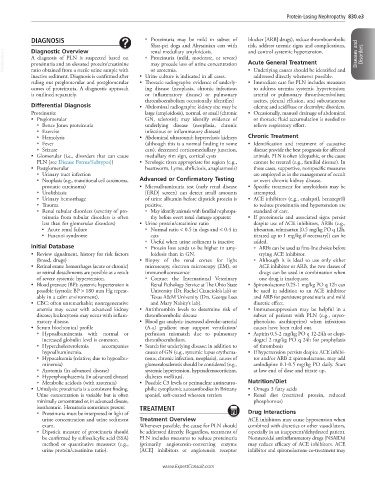Page 1650 - Cote clinical veterinary advisor dogs and cats 4th
P. 1650
Protein-Losing Nephropathy 830.e3
DIAGNOSIS ○ Proteinuria may be mild in subset of blocker [ARB] drugs), reduce thromboembolic
Shar-pei dogs and Abyssinian cats with risk, address uremic signs and complications,
Diagnostic Overview
VetBooks.ir A diagnosis of PLN is suspected based on ○ Proteinuria (mild, moderate, or severe) Acute General Treatment Diseases and Disorders
and control systemic hypertension.
renal medullary amyloidosis.
may precede loss of urine concentration
proteinuria and an elevated protein/creatinine
ratio obtained from a sterile urine sample with
or azotemia.
inactive sediment. Diagnosis is confirmed after • Urine culture is indicated in all cases. • Underlying causes should be identified and
addressed directly whenever possible.
ruling out preglomerular and postglomerular • Thoracic radiographs: evidence of underly- • Immediate care for PLN includes measures
causes of proteinuria. A diagnostic approach ing disease (neoplasia, chronic infectious to address uremia; systemic hypertension;
is outlined separately. or inflammatory disease) or pulmonary arterial or pulmonary thromboembolism;
thromboembolism occasionally identified ascites, pleural effusion, and subcutaneous
Differential Diagnosis • Abdominal radiographs: kidney size may be edema; and acid/base or electrolyte disorders.
Proteinuria: large (amyloidosis), normal, or small (chronic • Occasionally, manual drainage of abdominal
• Preglomerular GN, sclerosis); may identify evidence of or thoracic fluid accumulation is needed to
○ Bence Jones proteinuria underlying disease (neoplasia, chronic relieve respiratory effort.
○ Exercise infectious or inflammatory disease)
○ Hemolysis • Abdominal ultrasound: hyperechoic kidneys Chronic Treatment
○ Fever (although this is a normal finding in some • Identification and treatment of causative
○ Seizure cats), decreased corticomedullary junction, disease provide the best prognosis for affected
• Glomerular (i.e., disorders that can cause medullary rim sign, cortical cysts animals. PLN is often idiopathic, or the cause
PLN [see Disease Forms/Subtypes]) • Serologic titers appropriate for region (e.g., cannot be treated (e.g., familial disease). In
• Postglomerular heartworm, Lyme, ehrliciosis, anaplasmosis) these cases, supportive, nonspecific measures
○ Urinary tract infection are employed as in the management of occult
○ Neoplasia (e.g., transitional cell carcinoma, Advanced or Confirmatory Testing or overt chronic kidney disease.
prostatic carcinoma) • Microalbuminuria test (early renal disease • Specific treatment for amyloidosis may be
○ Urolithiasis [ERD] screen) can detect small amounts attempted.
○ Urinary hemorrhage of urine albumin before dipstick protein is • ACE inhibitors (e.g., enalapril, benazepril)
○ Trauma positive. to reduce proteinuria and hypertension are
○ Renal tubular disorders (severity of pro- ○ May identify animals with familial nephropa- standard of care.
teinuria from tubular disorders is often thy before overt renal damage apparent • If proteinuria and associated signs persist
less than for glomerular disorders) • Urine protein/creatinine ratio despite use of ACE inhibitors, ARBs (e.g.,
Acute renal failure ○ Normal ratio < 0.5 in dogs and < 0.4 in irbesartan, telmisartan [0.5 mg/kg PO q 12h,
■
Fanconi syndrome cats titrated up to 1 mg/kg if necessary]) can be
■
○ Useful when urine sediment is inactive added.
Initial Database ○ Protein loss tends to be higher in amy- ○ ARBs can be used as first-line choice before
• Review signalment, history for risk factors loidosis than in GN. trying ACE inhibitor.
(breed, drugs) • Biopsy of the renal cortex for light ○ Although it is ideal to use only either
• Retinal exam: hemorrhages (acute or chronic) microscopy, electron microscopy (EM), or ACE inhibitor or ARB, the two classes of
or retinal detachments are possible as a result immunofluorescence drugs can be used in combination when
of severe systemic hypertension. ○ Contact the International Veterinary one drug is inadequate.
• Blood pressure (BP): systemic hypertension is Renal Pathology Service at The Ohio State • Spironolactone 0.25-1 mg/kg PO q 12h can
possible (systolic BP > 180 mm Hg repeat- University (Dr. Rachel Cianciolo’s lab) or be used in addition to an ACE inhibitor
ably in a calm environment). Texas A&M University (Drs. George Lees and ARB for persistent proteinuria and mild
• CBC: often unremarkable; nonregenerative and Mary Nabity’s lab). diuretic effect.
anemia may occur with advanced kidney • Antithrombin levels to determine risk of • Immunosuppression may be helpful in a
disease; leukocytosis may occur with inflam- thromboembolic disease subset of patients with PLN (e.g., myco-
matory disease. • Blood gas analysis: increased alveolar-arterial phenolate, azathioprine) when infectious
• Serum biochemical profile (A-a) gradient may support ventilation/ causes have been ruled out.
○ Hypoalbuminemia with normal or perfusion mismatch due to pulmonary • Aspirin 0.5-2 mg/kg PO q 12-24h or clopi-
increased globulin level is common. thromboembolism. dogrel 2 mg/kg PO q 24h for prophylaxis
○ Hypercholesterolemia accompanies • Search for underlying disease; in addition to of thrombosis
hypoalbuminemia. causes of GN (e.g., systemic lupus erythema- • If hypertension persists despite ACE inhibi-
○ Hypocalcemia (relative; due to hypoalbu- tosus, chronic infection, neoplasia), causes of tor and/or ARB ± spironolactone, may add
minemia) glomerulosclerosis should be considered (e.g., amlodipine 0.1-0.5 mg/kg PO daily. Start
○ Azotemia (in advanced disease) systemic hypertension, hyperadrenocorticism, at low end of dose and titrate up.
○ Hyperphosphatemia (in advanced disease) diabetes mellitus).
○ Metabolic acidosis (with azotemia) • Possible C3 levels or perinuclear antineutro- Nutrition/Diet
• Urinalysis: proteinuria is a consistent finding. philic cytoplasmic autoantibodies in Brittany • Omega 3 fatty acids
Urine concentration is variable but is often spaniel, soft-coated wheaten terriers • Renal diet (restricted protein, reduced
minimally concentrated or, in advanced disease, phosphorous)
isosthenuric. Hematuria sometimes present TREATMENT
○ Proteinuria must be interpreted in light of Drug Interactions
urine concentration and urine sediment Treatment Overview ACE inhibitors may cause hypotension when
exam. Whenever possible, the cause for PLN should combined with diuretics or other vasodilators,
○ Dipstick measure of proteinuria should be addressed directly. Regardless, treatment of especially in an inappetent/dehydrated patient.
be confirmed by sulfosalicylic acid (SSA) PLN includes measures to reduce proteinuria Nonsteroidal antiinflammatory drugs (NSAIDs)
method or quantitative measures (e.g., (primarily angiotensin-converting enzyme may reduce efficacy of ACE inhibitors. ACE
urine protein/creatinine ratio). [ACE] inhibitors or angiotensin receptor inhibitor and spironolactone co-treatment may
www.ExpertConsult.com

